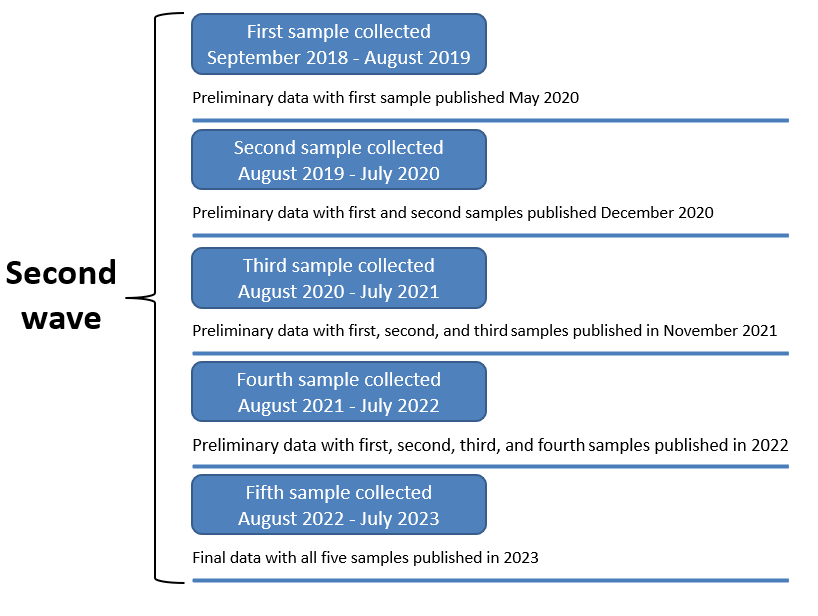An official website of the United States government
 United States Department of Labor
United States Department of Labor
Hover over the red dot to see historical information.
October 2012: Occupational Requirements Survey (ORS) established as a test survey.
November 2012: Phase one test: Initial proof of concept.
January 2013: Phase two test: Collection protocol testing.
April 2013: Phase three test: Broad scale testing.
November–December 2013: Observation test conducted concurrently with other fiscal year 2014 tests:1
ORS-only efficiency innovations test
Central Office Collection elements test
National Compensation Survey (NCS)/ORS joint collection test
New data element tests
February 2014: Alternative modes test.
October 2014–September 2015: Preproduction testing (collection, review, estimation, and validation).
June 2015: Job observations pilot test.
September 2015–July 2016: First sample in the first wave collected.
May 2016–July 2017: Second sample in first wave collected.
December 2016: Published 2016 reference year estimates from one sample in the first wave.
June 2017–September 2017: Job observations test.
August 2017–July 2018: Third sample in the first wave collected.
Narrowed the scope of collection. Initially field economists collected job requirements based on how workers generally performed job tasks. The survey scope was narrowed to include job requirements based on workers performing critical tasks in support of critical job functions.
Tested the revised cognitive and mental requirements
November 2017: Published 2017 reference year estimates which combined data from two samples in the first wave.
February 2018–August 2018: Job observation test. More information on this job observation test can be found in Observational collection compared to critical task threshold interview collection in the Occupational Requirements Survey.
September 2018–August 2019: Collected first sample in the second wave. See Exhibit 1.
Second wave includes five samples
Updated occupational selection process from modeled occupational frame for private industry
Survey measurement changes to include cognitive and mental requirements as well as low posture (crawling, crouching, kneeling, stooping) requirements
February 2019: Published 2018 reference year estimates which combined data from three samples in the first wave.
August 2019–July 2020: Second sample in the second wave collected.
May 2020: Published 2019 reference year estimates to include cognitive and mental requirements.
August 2020–July 2021: Collected third sample in the second wave.
December 2020: Published 2020 reference year estimates.
August 2021–July 2022: Collected fourth sample in the second wave.
November 2021: Published 2021 reference year estimates.
August 2022–July 2023: Collected fifth sample in the second wave.
November 2022: Published 2022 reference year estimates.
February 2024: Published 2023 reference year estimates, which combined all samples of the second wave and introduced range estimates.

The Social Security Administration (SSA) and U.S. Bureau of Labor Statistics (BLS) sign annual interagency agreements for BLS to produce estimates on occupational requirements. These estimates will assist the SSA in making accurate disability determinations and decisions. SSA also intends to use ORS estimates, along with information from other occupational sources, to create the Occupational Information System (OIS).
During the developmental stages of the ORS, BLS identified the existing infrastructure available to coordinate with the ORS, which had the capability to manage and implement a new survey to meet data needs. The infrastructure included systems and processes to support all the steps of the survey. In addition, field economists who work on the NCS were already familiar with collecting data elements like those captured by the ORS. For example, the NCS program classifies each job selected using the Standard Occupational Classification (SOC) system, collects worker characteristics (such as bargaining status and part-time or full-time workers), and determines industry classification using the North American Industry Classification System (NAICS) for sampled establishments. In addition, BLS is collecting and publishing information on the knowledge required to perform the job, job controls provided, the complexity of tasks, the contacts made by workers, and the physical environment where the work is performed.2 After the initial assessment of whether BLS could collect job requirements, BLS began testing the collection of these requirements.
BLS established ORS as a test survey in fiscal year 2013. In fiscal years 2013 and 2014, several feasibility tests were performed to assess the viability of collecting data on occupational requirements using the platform used by the NCS. Test objectives were successfully met, and the findings from these tests suggested that the collection of the ORS data was viable.
As a result of fiscal year 2013 testing, areas were identified where further testing was needed before moving to full-scale production. In fiscal year 2014, five feasibility tests were completed to refine ORS methodology tested in previous phases. These tests provided evidence that the NCS platform could be adapted to ORS data collection.
Testing activities in fiscal years 2013 and 2014 laid the foundation for the preproduction test conducted in fiscal year 2015. The preproduction test was designed as a relatively large-scale, nationally representative test of ORS data collection. The sampling, data collection, procedures, and review were designed to mimic what would occur during ORS production. Results from the ORS preproduction test demonstrated that data on occupational requirements could be collected using the processes established by BLS.
Detailed information on completed tests and other testing activities can be found on the ORS research page.
1 The fiscal year for the U.S. Bureau of Labor Statistics and other federal agencies spans from October 1 through September 30.
2 This information is published as part of the Modeled Wage Estimates. The job characteristics include work levels, which show the difference in average hourly wages based on a range of skills, knowledge, and duties within an occupation. Information about determining work levels is available through the National Compensation Survey: Guide for Evaluating Your Firm’s Jobs and Pay and the Modeled Wage Estimates questions and answers.